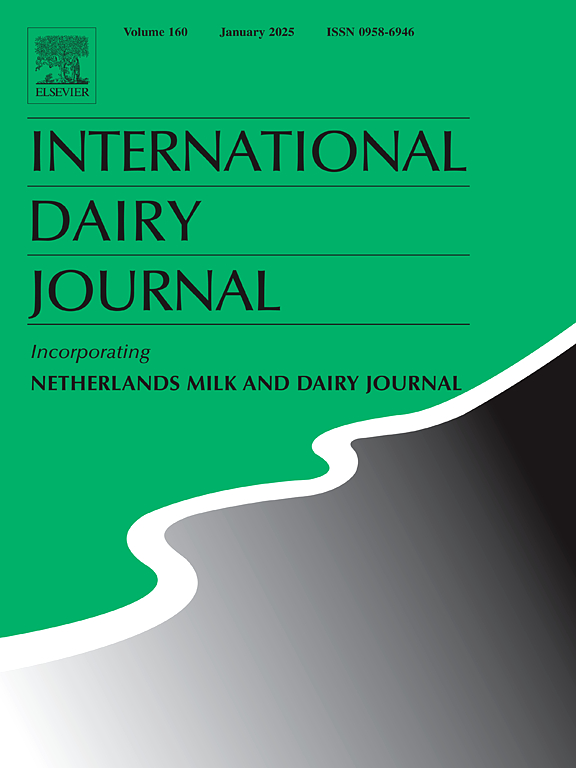利用拉曼光谱预测 UHT 重构脱脂奶在常温储存后的相稳定性
IF 3.1
3区 农林科学
Q2 FOOD SCIENCE & TECHNOLOGY
引用次数: 0
摘要
牛奶是一种胶体系统,这种系统中的相分离(如过度沉淀和老化凝胶化)是超高温灭菌处理牛奶中的一种质量缺陷,目前仍难以预测。本研究旨在探讨使用拉曼光谱表征 UHT 重构脱脂牛奶(RSM)的可行性,并预测 UHT-RSM 在储存后的相分离程度。对加工后(M0)和储存三个月后(M3)的 UHT-RSM 样品进行真空浓缩,并用拉曼光谱进行分析。贮存 7.5 个月后,UHT-RSM 的总固体损耗(TSD)被用来定量反映相分离的程度。以 TSD7.5 个月为响应变量,以分别从 M0 和 M3 收集的预处理拉曼光谱为预测变量,建立了两个独立的偏最小二乘法回归模型。拉曼光谱捕捉到的 UHT-RSM 样品的细微差别对建立 PLS 回归模型至关重要。结果表明,M0 和 M3 拉曼光谱都能比较有效地预测 UHT-RSM 在贮藏后期的相分离状况(TSD7.5-月)(R2Pred 分别为 0.74 和 0.85)。这项研究展示了一种基于光谱信息预测 UHT-RSM 产品相稳定性的新方法。虽然所提出的预测模型还有优化的空间,但该技术方法显示出很好的潜力,可被配料生产商和 UHT 牛奶加工商用来协助配料筛选过程。我们鼓励未来的研究在这种新方法的框架内提高预测的准确性。本文章由计算机程序翻译,如有差异,请以英文原文为准。
Prediction of phase stability of UHT reconstituted skim milk after ambient storage using Raman spectroscopy
Milk is a colloidal system, and phase separation within such systems, such as excessive sedimentation and age gelation, is a quality defect in UHT-treated milk that remains challenging to predict. This study aims to investigate the feasibility of using Raman spectroscopy to characterize UHT reconstituted skim milk (RSM) and predict the degree of phase separation in UHT-RSM after storage. UHT-RSM samples after processing (M0) and three-month storage (M3) were vacuum-concentrated and analyzed by Raman spectroscopy. After 7.5 months of storage, the total solids depletion (TSD) of UHT-RSM was used to quantitatively reflect the degree of phase separation. Two independent partial least squares regression models were constructed using TSD7.5-month as the response variable and pre-processed Raman spectra collected from M0 and M3, respectively, as predictor variables. The nuances in UHT-RSM samples captured by Raman spectroscopy are crucial in developing the PLS regression models. Results showed that both M0 and M3 Raman spectra were relatively effective in predicting the phase separation condition (TSD7.5-month) of UHT-RSM at a later stage of storage (R2Pred = 0.74 and 0.85, respectively). This study demonstrated a new approach for forecasting the phase stability of UHT-RSM products based on spectral information. While there is a space for optimization of the presented prediction models, the technical approach shows good potential to be utilized by ingredient manufacturers and UHT milk processors to assist the ingredient screening process. Future research is encouraged to improve prediction accuracy within the framework of this novel approach.
求助全文
通过发布文献求助,成功后即可免费获取论文全文。
去求助
来源期刊

International Dairy Journal
工程技术-食品科技
CiteScore
6.50
自引率
9.70%
发文量
200
审稿时长
49 days
期刊介绍:
The International Dairy Journal publishes significant advancements in dairy science and technology in the form of research articles and critical reviews that are of relevance to the broader international dairy community. Within this scope, research on the science and technology of milk and dairy products and the nutritional and health aspects of dairy foods are included; the journal pays particular attention to applied research and its interface with the dairy industry.
The journal''s coverage includes the following, where directly applicable to dairy science and technology:
• Chemistry and physico-chemical properties of milk constituents
• Microbiology, food safety, enzymology, biotechnology
• Processing and engineering
• Emulsion science, food structure, and texture
• Raw material quality and effect on relevant products
• Flavour and off-flavour development
• Technological functionality and applications of dairy ingredients
• Sensory and consumer sciences
• Nutrition and substantiation of human health implications of milk components or dairy products
International Dairy Journal does not publish papers related to milk production, animal health and other aspects of on-farm milk production unless there is a clear relationship to dairy technology, human health or final product quality.
 求助内容:
求助内容: 应助结果提醒方式:
应助结果提醒方式:


